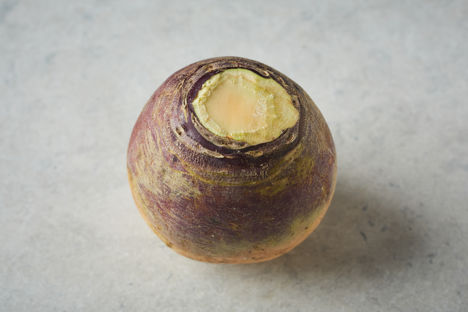How to cook swede
For a pretty underused vegetable, the humble swede goes by a surprising number of names: rutabaga, Swedish turnip or in Scotland and parts of northern England it is confusingly known as neeps or turnip (not to be confused with the smaller, white turnip which looks and tastes quite different). It is a root vegetable, in season from October to February in the UK. Swede is a great source of vitamin C in particular, and makes a good alternative to potatoes if you’re on a low-carb diet as they are low in carbohydrates, unlike a lot of other root vegetables.
Before pumpkins were readily available in the UK, swedes were often carved into a threatening face at Halloween and left in windows of homes and shops to ward off evil spirits. They've developed a bit of a reputation for being bland, bitter and just generally uninteresting, but that couldn't be further from the truth – with the right know-how and recipe, swede can be a beautiful side dish to a Sunday roast or even the star of the show.
What to look for when buying swede
Select a firm, dense, blemish-free swede, the smaller in size the sweeter so a small-medium is probably best depending on how you are using it. Avoid larger swedes as they can become more bitter in taste and tougher, meaning longer cooking times.
How to prepare swede
To prepare swede, it can be treated the same as other root vegetables – it simply needs peeling and the root cutting off. From here you can dice to the desired size then roast, boil or steam it. As it is a hardy winter vegetable, it is suited to long braises such as soups or hearty stews. Follow our simple recipes below for crushed swede and how to roast swede, then take a look at our other swede recipes for plenty more inspiration.
How to make crushed swede
Metric
Imperial
- 1 swede
- 50g of butter
- 1 pinch of sugar
- salt
- freshly ground black pepper
Peel and roughly dice the swede into 2cm cubes. Place in a pan and cover with boiling water and a good pinch of salt. Boil for 20–25 minutes or until tender but not overly soft, otherwise it will taste watery
Drain the swede then place back in the pan with the butter and use a potato mash to crush
Taste and season with a pinch of sugar, salt and plenty of freshly ground black pepper. The sugar may not be needed but for larger, tougher swedes it can counteract the bitterness
How to roast swede
Metric
Imperial
- 1 swede
- 1 dash of olive oil
- 1 handful of sage, rosemary or thyme
- 3 garlic cloves, bashed in their skins
- salt
- freshly ground black pepper
Preheat an oven to 200ºC/gas mark 6
Peel and dice the swede into 2cm pieces
Scatter the swede onto a roasting tray with the herbs and garlic cloves, lightly bashed and still in their skins. Drizzle with olive oil and season with salt and pepper, then toss to thoroughly coat in the oil
Place in the oven and roast for 30 minutes, tossing halfway through to get an even caramelisation on the swede
Serve up hot
Scottish inspiration
Sneaky swede
Swede on the side
Crushed, mashed and hashed
Comforting swede recipes
Puddings and pies
Swede and friends
The sweet and earthy flavour of swede pairs nicely with a sweet and sharp apple. Mustard is another nice ingredient to pair with swede, which actually comes from the same family as the mustard plant. The hot, sharp flavour really complements the sweetness of the swede and enhances the slightly peppery flavour.
Salt-baked swede
Swede with game
Get in touch
Please sign in or register to send a comment to Great British Chefs.


